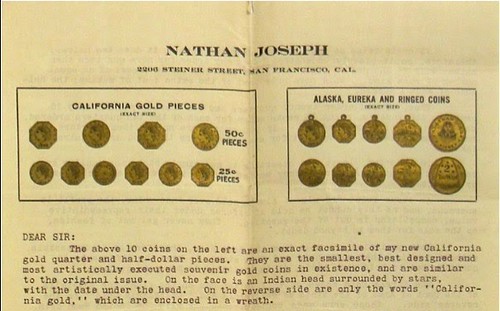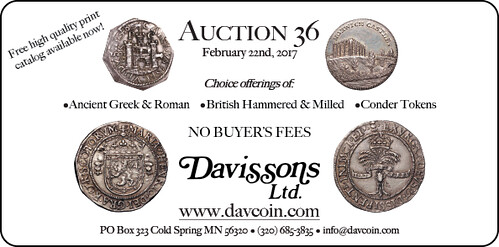
PREV ARTICLE
NEXT ARTICLE
FULL ISSUE
PREV FULL ISSUE
MORE ON THE JOSEPHS AND NUMISMATIC RESEARCH

Bob Leonard writes: John Lupia's Encyclopedic Dictionary article on the Joseph Brothers (The E-Sylum, v20 n02, January 8, 2017) was written without consulting the standard catalog on the subject, Breen-Gillio's California Pioneer Fractional Gold, second edition, 2003. Rulau's errors were corrected over 13 years ago, not by Mr. Lupia, and even he does not have it quite right; the Joseph Brothers' store cards were made in Birmingham, England. Also, his statement that "None of the fractional gold pieces produced by the Joseph Brothers are listed in Edgar Holmes Adams (1868-1940), Adams' Official Premium List of United States Private and Territorial Gold Coins," while correct, is misleading; Adams omitted ALL small California gold pieces from his listing, not just these. If you follow the link to the article from which this is excerpted, Lupia disputes the attribution of certain pieces to the Joseph Brothers, and "refutes" a statement by Dr. Robert J. Chandler, in-house historian for the Wells Fargo museum and a collector and student of small California gold coins, in a 2013 Holabird-Kagin auction catalog. He writes that Chandler "cited a quotation from a Louisiana newspaper published in June 1852 purporting it identified the half dollar gold coin as minted by the Joseph Brothers. Neither any identification of the diesinker(s) nor coiner(s) was ever made in that Times-Picayune, Tuesday, June 29, 1852, page 1 story." (1) NO contemporary newspaper article yet discovered identifies any maker of Period One small California gold. (2) I discovered this article myself in the History Room of the New Orleans Public Library while researching the book, having figured out approximately when it appeared. (3) Dr. Chandler is not wrong in associating this fully-described piece with the Joseph Brothers, based on what we know of their issues. (4) The catalog numbers in the Holabird-Kagin catalog refer to Breen-Gillio, and the collection cataloged (by me) is that of co-author Jack Totheroh. While some details could be updated, I stand behind the account of the Joseph Brothers' business in California Pioneer Fractional Gold, second edition, which is based in part on sources unknown to Lupia--and includes a portrait of Nathan Joseph. And I also affirm the carefully-qualified attributions of certain anonymous halves and quarters to them. Lupia has added a reference to my book in his article, but without mentioning that it contradicts his account.
I thank Bob for submitting these notes as a follow-up. I've been in touch with John Lupia; he has ordered a copy of the Breen-Gillio book, and may make some further updates to his piece on the Josephs. A key point is that he, like many researchers, prefers working from primary sources. Even the best book on a topic is a secondary source from authors who may have used different primary sources and/or made different conclusions based on their review of those sources. Of course, one shouldn't stop there, and a review of secondary sources can reveal other primary material and alternate timelines and interpretations. -Editor Bob Leonard continues: Nothing should be submitted for posting or publication without consulting the standard literature on the subject. This is the very beginning of research; for U.S. coins, for example, start with the Red Book, then look at the bibliography in the back and read everything relevant to the particular subject. Read the bibliographies in those references, and consult the works mentioned, then search for updates in the form of articles and internet postings. Only then are you in a position to place the material you have in proper context. And even then, you're not finished; submit a draft of your article or book chapter to experts in the field who may know more than you and solicit their comments. This is the method of Q. David Bowers (at least for books), and I have followed it for all my books and articles.
Bob and I are in perfect agreement on these points. Where we differ is on the level of review appropriate for an internet blog like The E-Sylum, or a web site like John Lupia's, which is a living draft of the Encyclopedic Dictionary of Numismatic Biographies he hopes to publish in print someday. As for The E-Sylum, I've pointed out many times that I'm a one-man operation with no bandwidth for coordinating independent reviews. I have no staff of fact-checkers. This is why we have numismatic book publishers like Whitman and paid subscription periodicals like Coin World. I gladly pay my subscription fees to help cover the cost of their highly capable professional staff. The E-Sylum, like the research process itself, is a conversation, not the Final Word on any topic. Our readers are our fact-checkers, and you've come through in spades time and time again. Like Bob, please keep your helpful comments coming; we need the knowledge and experience of every single one of us to move closer to the fullest possible knowledge of numismatic truth. We'll look forward to more new biography articles from John Lupia, as well as any related thoughts and comments from readers. -Editor Bob adds: John Lupia prefers working from primary sources, as do I. Among others, I visited the California Historical Society Museum, and there purchased a copy of a portrait of Nathan Joseph and paid for publication rights. I also studied the small California gold coins of this period--also a primary source--based on the virtually exhaustive Jay Roe Collection and those of all other major collectors. Breen-Gillio, second edition, has copious footnotes referencing all sources used, so if the source is not actually quoted verbatim it is cited for any reader to verify. John responds: David Sklow is mailing me the book. Bob makes it sound like I attributed the store card, but I did not. I only mentioned Melvin and George Fuld who thought there might be links to Moise. But the point I was making was not about who manufactured the store card but the glaring fact that experts thought someone other than the Joseph Brothers designed and coined it. That seems to be a pretty important fact when others are attempting to date fractional gold designed and coined by them at the same period. His complaint that I refute Dr. Robert J. Chandler associating the 1850 fractional gold described in the New Orleans Picayune of June 29, 1850, as that manufactured by the Joseph Brothers is groundless. Even Nathan Joseph in his own circular dates the pieces to 1852 based on the best of his recollection, and my research confirmed that as the earliest possible date. That is pretty important too, since it is an outside source confirming Nathan Joseph'e claim regarding the dating of the pieces. I was and still am attempting to correct the view that that the Joseph brothers immediately left Liverpool in 1849 hearing about the gold rush and arriving at San Francisco began manufacturing fractional gold. The reality is not before 1852 and not after the time they left 1865-1867, unless we refer to Nathan's reproductions in 1912-1913. Mr. Leonard objected to the use of the illustration taken from their 1854-1860 letterhead since according to him they did not make fractional gold at that time. Maybe he is right about all these points based on documentation not accessible to me at the time of my writing. Consequently, I am eager to read the second edition of the Breen/Gillio, California Pioneer Fractional Gold and will gladly make any necessary additions or corrections based on the facts presented therein. I would like to thank Bob Leonard for pointing out the value of that book and look forward to reading it. Thanks again, especially to Wayne who does such great work!
To read the earlier E-Sylum article, see:

Wayne Homren, Editor The Numismatic Bibliomania Society is a non-profit organization promoting numismatic literature. See our web site at coinbooks.org. To submit items for publication in The E-Sylum, write to the Editor at this address: whomren@gmail.com To subscribe go to: https://my.binhost.com/lists/listinfo/esylum All Rights Reserved. NBS Home Page Contact the NBS webmaster 
|